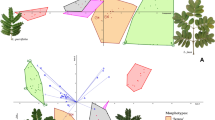Abstract
Two experiments were carried out using two different approaches to compare populations ofCrepis tectorum (Asteraceae). One was based on a comparison of means of various vegetative and reproductive characters and another was based on a comparison of response patterns of the same characters in a series of environments. Population divergence within two earlier recognized form series, one from weed habitats and one from alvar habitats on Baltic islands, resulted in a partially overlapping pattern in cluster analyses based on character means. However, the pattern revealed by a comparison of the direction and amount of plastic response suggested that populations within the two form series had more similar response patterns than other combinations of populations. It was concluded that patterns of plasticity may provide useful additional information on the overall similarity among taxa. An hypothesis that plants in weed populations should exhibit a greater phenotypic response to the environments than plants in alvar populations was rejected.
Similar content being viewed by others
References
Andersson, S., 1988: Limiting factors on seed production inCrepis tectorum ssp.pumila. — Acta Phytogeographica Suecica76: 9–20.
—, 1989: Variation in heteroblastic succession among populations ofCrepis tectorum. — Nordic J. Bot.8: 565–573.
Babcock, E. B., 1947: The genusCrepis 1–2. — Berkely, Los Angeles: University of California Press.
Baker, H. G., 1974: The evolution of weeds. — Ann. Rev. Ecol. Syst.5: 1–24.
Bengtsson, K., Prentice, H. C., Rosėn, E., Moberg, R., Sjögren, E., 1988: The dry alvar grasslands of Öland: ecological amplitudes of plant species in relation to vegetation composition. — Acta Phytogeographica Suecica76: 21–46.
Bradshaw, A. D., 1965: Evolutionary significance of phenotypic plasticity in plants. — Adv. Genet.13: 115–155.
Clausen, J.,Keck, D. D.,Hiesey, W. M., 1940: Experimental studies on the nature of species. 1. Effect of varied environments on western North American plants. — Carnegie Inst. Wash. Publ.520.
- - - 1948: Experimental studies on the nature of plant species. 3. Environmental responses of climatic races ofAchillea. — Carnegie Inst. Wash. Publ.581.
Cook, S. A., Johnson, M. P., 1968: Adaptation to heterogenous environments. 1 Variation in heterophylly inRanunculus flammula L. — Evolution22: 496–516.
Dunn, G., Everitt, B. S., 1982: An introduction to mathematical taxonomy. — Cambridge: Cambridge University Press.
Givnish, T. J., 1987: Comparative studies of leaf form: assessing the relative roles of selective pressures and phylogenetic constraints. — New Phytol.106 (suppl.): 131–160.
Jain, S. K., 1979: Adaptive strategies: polymorphism, plasticity and homeostasis. — InSolbrig, O. T., Jain, S., Johnson, G. B., Raven, P. H., (Eds.): Topics in plant population biology, pp. 160–187. — New York: Columbia University Press.
Lerner, I. M., 1954: Genetic homeostasis. — Edinburgh, London: Oliver & Boyd.
Levins, R., 1968: Evolution in changing environments. — Princeton: Princeton University Press.
Marshall, D. R., Jain, S. K., 1968: Phenotypic plasticity ofAvena fatua andAvena barbata. — Amer. Naturalist102: 457–467.
Moran, G. F., Marshall, D. R., Muller, W. J., 1981: Phenotypic variation and plasticity in the colonizing speciesXanthium strumarium L. (Noogoora Burr). — Austral. J. Biol. Sci.34: 639–648.
Morisset, P., Boutin, C., 1984: The biosystematic importance of phenotypic plasticity. — InGrant, W. F., (Ed.): Plant biosystematics, pp. 293–306. — Ontario: Academic Press.
Petterson, B., 1958: Dynamik och konstans i Gotlands flora och vegetation. — Acta Phytogeographica Suecica40: 1–288.
—, 1965: Gotland and Öland. Two limestone islands compared. — Acta Phytogeographica Suecica50: 131–140.
Quinn, J. A., Hodgkinson, K. C., 1983: Population variability inDanthonia caespitosa (Gramineae) in responses to increasing density under three temperature regimes. — Amer. J. Bot.70: 1425–1431.
Salisbury, E., 1942: The reproductive capacity of plants. — London: Bell.
Schlichting, C. D., 1986: The evolution of phenotypic plasticity in plants. — Ann. Rev. Ecol. Syst.17: 667–693.
—, Levin, D. A., 1984: Phenotypic plasticity of annual phlox: tests of some hypotheses. — Amer. J. Bot.71: 252–260.
—, —, 1986: Effects of inbreeding on phenotypic plasticity in cultivatedPhlox drummondii. — Theor. Appl. Genet.72: 114–119.
Sterner, R., 1938: Flora der Insel Öland. — Acta Phytogeographica Suecica9.
Sultan, S. E., 1987: Evolutionary implications of phenotypic plasticity in plants. — Evol. Biol.21: 127–178.
Via, S., Lande, R., 1985: Genotype-environment interaction and the evolution of phenotypic plasticity. — Evolution39: 505–522.
Waddington, C. H., 1959: Canalization of development and genetic assimilation of aquired characters. — Nature183: 1654–1655.
Wilken, D. H., 1977: Local differentiation for phenotypic plasticity in the annualCollomia linearis (Polemoniaceae). — Syst. Bot.2: 99–108.
Wilkinson, L., 1986: SYSTAT: the system for statistic. — Evanston, IL: SYSTAT.
Zimmerman, C. A., 1976: Growth characteristics of weediness inPortulaca oleracea. — Ecology57: 964–974.
Author information
Authors and Affiliations
Rights and permissions
About this article
Cite this article
Andersson, S. Phenotypic plasticity inCrepis tectorum (Asteraceae). Pl Syst Evol 168, 19–38 (1989). https://doi.org/10.1007/BF00936104
Received:
Revised:
Issue Date:
DOI: https://doi.org/10.1007/BF00936104




